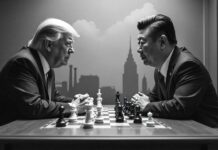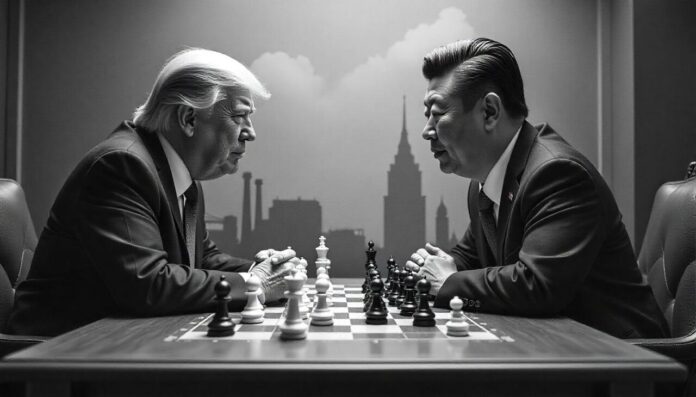
The global economy runs on trade. It is as simple as that. Containers move day and night across oceans, packed with coffee, semiconductors, shoes, phones, car parts, wheat, plastic forks, and sometimes, rubber ducks.
Now imagine a Wednesday morning when one country decides to slap a (miscalculated) tariff on every other country.
Well, we don’t have to imagine that thanks to Donald Trump and his administration. Namely, as everyone knows by now, President Donald Trump has significantly escalated trade tensions by imposing big tariffs on everyone and especially by putting a 125% tariff (increased to 145% on April 10th) on all Chinese imports.
Then in a stunning twist on April 9, 2025, Trump suddenly paused these retaliatory tariffs for all countries except China, keeping a 10% baseline while hiking China’s to 125%—and the stock market boomed, with the S&P 500 soaring 9.5% in its biggest daily gain since 2008.
And so, is this a masterful 3D chess move to isolate China and force global negotiations, or just panic as plummeting stock and bond markets rattled his resolve?
For now, we can’t be sure. Even though things with other countries seem somewhat better, there’s still a lot of uncertainty about his next move and what might happen.
Unfortunately, this might be only the beginning — unless a shred of reason and logic manages to emerge in the current U.S. and China administration.
So, let’s first look at the reality—using actual data, not the fabricated numbers initially presented by the Trump administration—and then we’ll take it from there.
Note: It is hard to update this article because of lunacy from both sides (China & US), as they change tariff models almost hourly.
Interesting fact: In 1930, the United States passed the Smoot-Hawley Tariff Act, which raised import duties on over 20,000 goods. World trade dropped by 65% within three years. Ok to be fair not only because of tariffs, but also because of the global economic crisis—the Great Depression itself. Nonetheless, tariffs only increased the crisis.
Average Tariffs Between the U.S. and Its Top Trading Partners
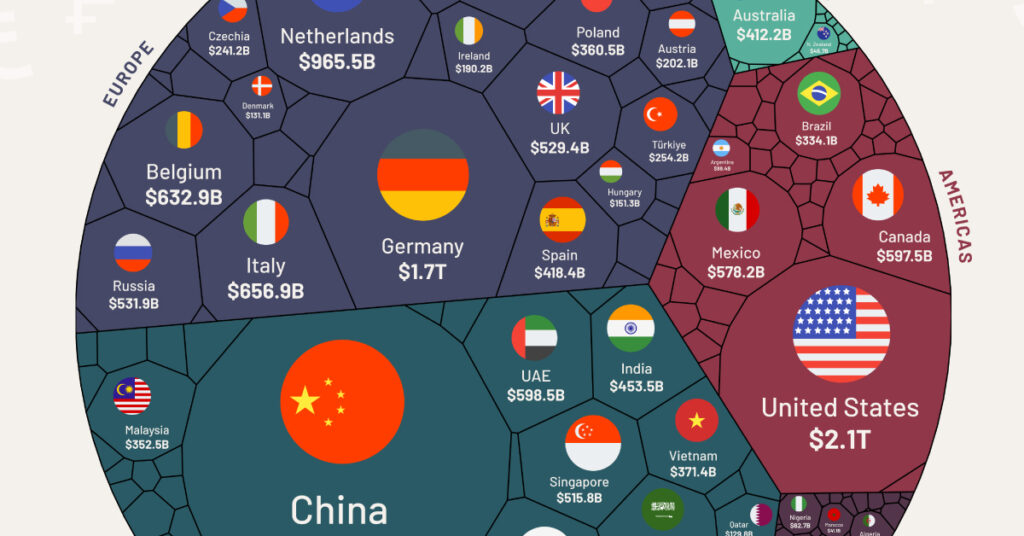
| Country | U.S. Tariffs on Imports (%) – 2024 | U.S. Tariffs on Imports (%) – April 2025 | Partner’s Tariffs on U.S. Exports (%) – 2024 | Partner’s Tariffs on U.S. Exports (%) – April 2025 |
| Canada | 0.8 (USMCA) | 10.0 (baseline) | 1 | 25.0 (retaliation March 4) |
| Mexico | 0.8 (USMCA) | 10.0 (baseline) | 1.5 | 25.0 (retaliation assumed) |
| China | 19.3 (Section 301) | 145 (escalated April 10) | 8 | 84 (retaliation April 9), raised to 125 on April 11 |
| Japan | 1.6 | 10.0 (baseline, reciprocal paused) | 1.4 | 1.4 (no retaliation yet) |
| South Korea | 0.8 (KORUS FTA) | 10.0 (baseline) | 1.5 | 1.5 (no retaliation yet) |
| United Kingdom | 1.6 | 10.0 (baseline) | 1.6 | 1.6 (no retaliation yet) |
| India | 1.6 | 10.0 (baseline) | 12 | 12.0 (no retaliation yet) |
| Brazil | 1.6 | 10.0 (baseline) | 11.2 | 11.2 (no retaliation yet) |
| Taiwan | 1.6 | 10.0 (baseline, reciprocal paused) | 1.7 | 1.7 (no retaliation yet) |
| Switzerland | 1.6 | 10.0 (baseline) | 1.7 | 1.7 (no retaliation yet) |
| Australia | 0.0 (AUSFTA) | 10.0 (baseline) | 1.2 | 1.2 (no retaliation yet) |
| Thailand | 1.6 | 10.0 (baseline, reciprocal paused) | 4.5 | 4.5 (no retaliation yet) |
| Malaysia | 1.6 | 10.0 (baseline) | 4 | 4.0 (no retaliation yet) |
| Singapore | 0.0 (FTA) | 10.0 (baseline) | 0 | 0.0 (no retaliation yet) |
| Hong Kong | 1.6 | 10.0 (baseline) | 0 | 0.0 (no retaliation yet) |
| European Union (EU) | 1.6 (EU) | 10.0 (baseline, reciprocal paused) | 1.6 (EU) | Planned countermeasures but paused on April 10th. |
Notes on Methodology:
- 2024 U.S. Tariffs:
- Pre-2025 averages are low due to free trade agreements (e.g., USMCA, KORUS, AUSFTA) and a general U.S. weighted mean tariff of ~1.6%-2.5% (World Bank 2020, adjusted for Section 301 on China).
- China’s 19.3% reflects Section 301 tariffs from 2018-2024, averaging prior duties.
- April 2025 U.S. Tariffs:
- 10% Baseline: Applied to all imports starting April 5, 2025, per Trump’s executive order.
- China: Escalated to 145% effective April 10, 2025 (up from 54, 104, and 125).
- Reciprocal Tariffs: Paused for 90 days as of April 9, 2025
- Canada/Mexico: 10% baseline retained, 25% on non-USMCA goods paused.
- Partner Tariffs on U.S. Exports:
- 2024: Based on historical averages (e.g., World Bank, WTO, Pew Research 2016 adjusted).
- 2025: Updated for known retaliations:
- Canada: 25% on $30B of U.S. goods (Canada.ca, March 4, 2025).
- China: 84% on all U.S. goods, escalated April 9, 2025. Raised to 125 on April 11th.
- Mexico: Assumed 25% mirroring Canada, pending confirmation.
- EU: Planned 20% on €21–22 billion of U.S. goods (announced April 9, 2025), but paused for 90 days on April 10th.
- Others: No major retaliations announced yet.
- Assumptions:
- Where specific 2025 retaliatory tariffs are not yet detailed, 2024 rates are carried forward.
- Trade-weighted means are implied but not recalculated due to lack of real-time 2025 trade data.
Are Those the Biggest Tariffs Ever?
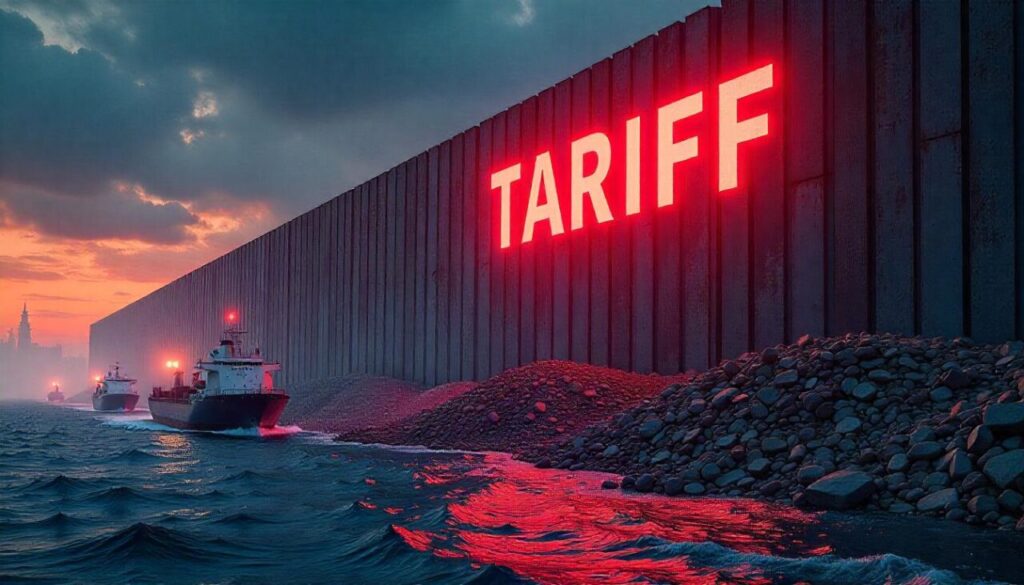
As mentioned, by spring 2025, the United States rolled out a wave of (mostly) nonsensical tariffs that felt less like economic policy and more like a shockwave through global trade. A flat 10% tax now applies to nearly all imports, and in China’s case, tariffs reach a staggering 145%.
This raises a big question: Are these the highest trade barriers the world has ever seen?
To find out, we have to again look back at history. In 1930, the U.S. passed the Smoot-Hawley Tariff Act during the Great Depression. It pushed average tariffs on taxed imports up to nearly 20%, with some goods facing up to 59%.
Countries hit back—Canada raised its tariffs to 30%, and Europe followed suit. As a result, world trade dropped by about two-thirds over four years.
But even then, the average tariff across all imports was around 14%, much lower than today’s 145% aimed at China, a country that sold the U.S. $438.8 billion worth of goods in 2024.
If we go even further back, we find examples like Britain’s Corn Laws in the 1800s, which taxed grain at rates between 20% and 50%, or the U.S. Morrill Tariff of 1861, which set rates around 26%.
These were high, but they focused on specific industries, not entire global supply chains.
In 2025, tariffs aren’t just high—they’re widespread, and nonsensical in many cases because they were not calculated based on reciprocity but on trade deficit formula.
And just five years ago, in 2020, the global average tariff was only 5.16%, according to the World Bank.
The U.S., which makes up 26% of the world economy, has now flipped that script completely. And based on that, every sane person must admit that this is completely insane.
This (miscalculated) move by Trump and his team could easily destroy the world as we know it. Nonetheless, let’s see if there’s even a shred—just the tiniest fragment—of reason behind what they’re doing.
Is There Any Logic Behind Trump’s Tariffs?
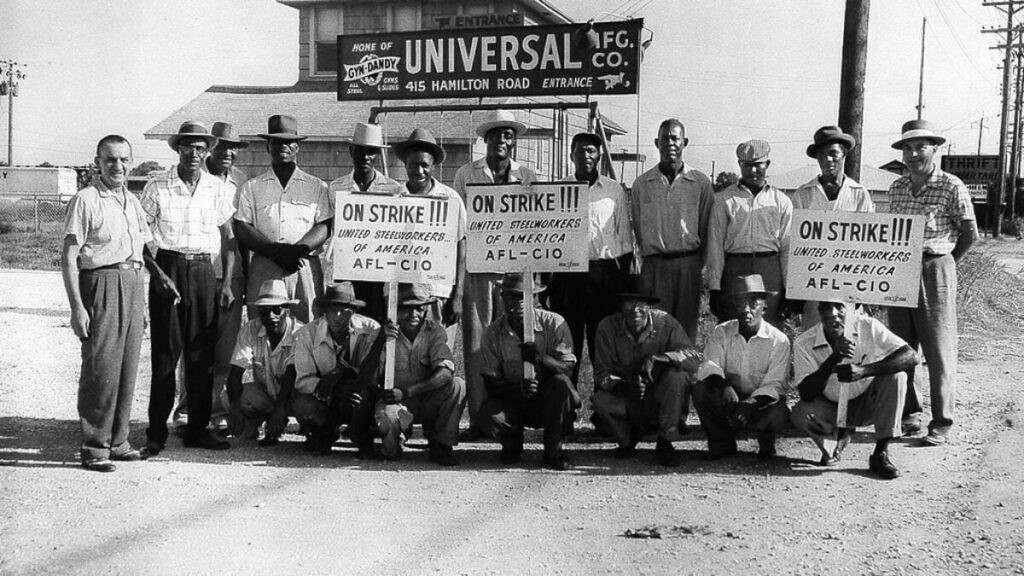
Here, at first we need to be fair and honest. United States has often gotten the short end of the stick when it comes to global trade. But to elaborate that we need to again take a look at history.
In the 1800s, Britain’s Corn Laws slapped tariffs of up to 50% on U.S. grain, choking farmers in the Midwest. After World War II, Japan locked its doors tight while flooding America with cars and TVs.
By the 1980s, the European Community—now the EU—was hitting U.S. farm exports with 20% tariffs, even after America rebuilt their cities from rubble.
Basically, over the past 30 years, the U.S. has maintained mostly lower average tariffs on imports compared to its trading partners. From 1989 to 2024, U.S. tariffs averaged between 1.5% and 2.5%, reflecting its commitment to free trade agreements like NAFTA/USMCA, KORUS, and AUSFTA, as well as WTO rules.
In contrast, many trading partners imposed higher tariffs on U.S. exports during this period. Additionally, developing economies consistently imposed higher tariffs on U.S. goods compared to the U.S.’s relatively low rates.
And so, the anger grew quietly.
Fast forward to 2025, and Donald Trump storms back, swinging tariffs at everyone like a wrecking ball.
His pitch is simple—the world’s been cheating the U.S. for decades, and it’s time to hit back.
But is there any logic behind such high proposed tariffs? The numbers scream BIG no, and the story’s actually uglier than he’ll admit.
Take China’s 145% tariff—it’s retaliation piled on top of earlier duties, aimed at a country that sold the U.S. $438.9 billion in goods last year. That’s not a nudge; it’s a complete shove off a cliff.
For regular Americans, unfortunately, it’s a kick in the wallet—a $50 blender from China now will cost well over $100. Inflation at 2.4%, could get a push toward 4 or even more.
Then there’s the retaliation. China struck back with 84% tariffs (raised to 125% on April 11th) on US goods.
Also, on April 9th, the European Union announced that they would impose a tariff on items such as soybeans, motorcycles, poultry, orange juice, tobacco, steel, aluminum, yachts, and diamonds. However, on April 10th, the EU also paused those tariffs.
Even South Korea, a longtime ally under the KORUS deal, gets the 10% tax, unraveling decades of goodwill.
The payoff? Expecting to raise manufacturing jobs in the US. But that’s not going to happen anytime soon.
Trump’s logic seems to be: hurt them until they beg. But it’s a gamble, not a plan. History’s got a grim receipt—Smoot-Hawley in 1930 sparked retaliation, trade crashed 66%, and the Great Depression dug deeper.
Today’s families, farmers, and shop owners are the ones paying, not Beijing or Brussels.
And here’s the kicker: Trump’s obsessed with the trade deficit—$918 billion in 2024 —but he’s partially ignoring the one area where America shines: services.
For example, in 2023, the U.S. exported services worth $1.02 trillion, including software, cloud computing, and intellectual property licensing, resulting in a services trade surplus of $278 billion
Companies like Microsoft, Apple, Meta, Alphabet, and many more make hundreds of billions overseas. Exports of services hit $1.11 billion last year (2024), dwarfing imports at $814 billion.
So, in a way, current rhetoric is nonsensical.
The U.S. is a services powerhouse—think Hollywood, Wall Street, Silicon Valley—yet Trump’s tariffs fixate on widgets, not bytes.
Why punish imports so hard when America’s real edge is in code and consulting?
It’s like a farmer burning his barn because the neighbor’s cow wandered over—wrong target, wrong fight.
And this could backfire, bad. Other countries might wake up and say, “Fine, you hit our goods, we’ll hit your services.” Imagine many countries banning Microsoft 365, Alphabet services, and Apple phones — or imposing heavy taxes on them.
What would happen then? How would Trump and his team react then?
That’d be hundreds of billions in U.S. exports disemboweled, not counting ripple effects—thousands of tech jobs lost, stock prices tanking.
Retaliation wouldn’t just be steel or soybeans; it’d be a digital dagger.
And seems like Trump’s team doesn’t see it—they’re stuck in a 1950s goods-only mindset while the world runs on apps and data.
This isn’t logic. It’s a blind swing that could boomerang, smashing America’s strongest hand. The tariff war’s already a mess—add a services backlash, and it’s a catastrophe.
And at the end of the day, while tariffs may feel like tough action (for Trump) when the dust settles, it’s American families, small businesses, and farmers who are left with the bill.
So, therefore we need to focus on them more in this article.
Consumers and Small Businesses Face the Worst Impact

Unfortunately, the 2025 tariff storm will hit American consumers and small business owners the hardest, showing just how tough (and miscalculated) Trump’s trade war is.
For consumers, the numbers are scary. For example, a pair of Nike shoes, usually made in China and sold for $100, now faces a 145% tariff, raising the price to $245. A $500 smartphone from China? Well, that jumps to $1225.
Yes, those are more than double the prices, and it’s completely unbelievable that this is happening.
And the hope that new U.S. factories would help balance this out is completely unrealistic. Building factories takes years, and most American workers actually prefer jobs with higher pay instead of factory work.
In 2024, manufacturing jobs made up only 8.8% of the U.S. workforce, and most people aren’t eager to take low-wage factory positions. Whether new factories get built or not, consumers are left with the burden of paying much higher prices.
But the problem goes deeper than just higher costs for everyday goods. The U.S. also relies heavily on China for critical supplies that impact public health. Around 80% of the raw materials needed to make antibiotics—a vital part of modern medicine—come from China. This makes America incredibly vulnerable.
In a worst-case scenario, if tariffs drive up costs or cause shortages (and they will) in these supplies, it could lead to higher healthcare costs, limited access to essential medications, and significant public health risks. Given that the U.S. is already struggling with rising healthcare costs, this is a ticking time bomb for American citizens.
Small business owners are in an extremely tough spot, too, with their supply chains thrown into complete chaos.
Let me just give you a few examples from REAL people and REAL business suffering already.
Casey Ames, a small business owner, shared his frustration on X: his order with a factory, which was originally set to cost $4,707 in tariffs for 2024, will now balloon to $101,673 because of “Liberation Day”. “How is anyone supposed to plan for this?” he asks, pointing out that the tariffs hit before he can even sell his products.
Sidenote: And btw this ballooning of costs was calculated when tariffs were 54%, not 145%.
Additionally, he’s adding: “And this all needs to be paid before I actually have the product in our warehouse ready to be sold. So, I’m now paying the US government $100k even before I have a chance to sell the inventory myself.”
And then continuing: “It’s just crazy that the tariffs can be announced and enacted between the time I put in a purchase order and it ships. What will the rest of the year look like? How can I possibly plan for Quarter 4 with so much volatility and uncertainty?”
Another business owner posted on Reddit about a $3,380 order of Chinese aluminum parts, which faced a $2,483.21 duty on March 31, 2025. That’s a 73% tariff, even before the new 145% hike. DHL gave him an ultimatum: pay or the parts get sent back in five days.
Then we also have the following small business owner who built his small shop:
“54% Tariff Bamboo Shops! Any other small shops trying to figure out what to do? I’ve single-handedly created and ran my small business for almost three years. I sell bamboo clothing and bedding, and now with this tariff, I’ll likely have to close. Does anyone have any American-based manufacturers? I’m devastated that all my hard work is going to be pulled out from underneath. I just hit my 10,000 order last week.”
Additionally, most famous YouTuber, MrBeast also posted on X saying: “Ironically because of all the new tariffs it is now way cheaper to make our chocolate bars we sell globally NOT in America because other countries don’t have a 20%+ tariff on our cogs.”
Pure disaster for every business owner!
With 60% of small businesses operating on profit margins under 5%, most can’t absorb these extra costs. The choice for many is simple but painful: raise prices and risk losing customers, or shut down.
Basically, in this tariff storm, small businesses and consumers are stuck in a situation where planning has become a luxury they can’t afford. How can you plan anything when the president is changing the tariff model almost daily — or perhaps even multiple times a day? This is not an environment where anyone can run a business.
This is simply not a normal business environment.
So, the question remains…
So Who Are The Winners and Losers in this Trade War?
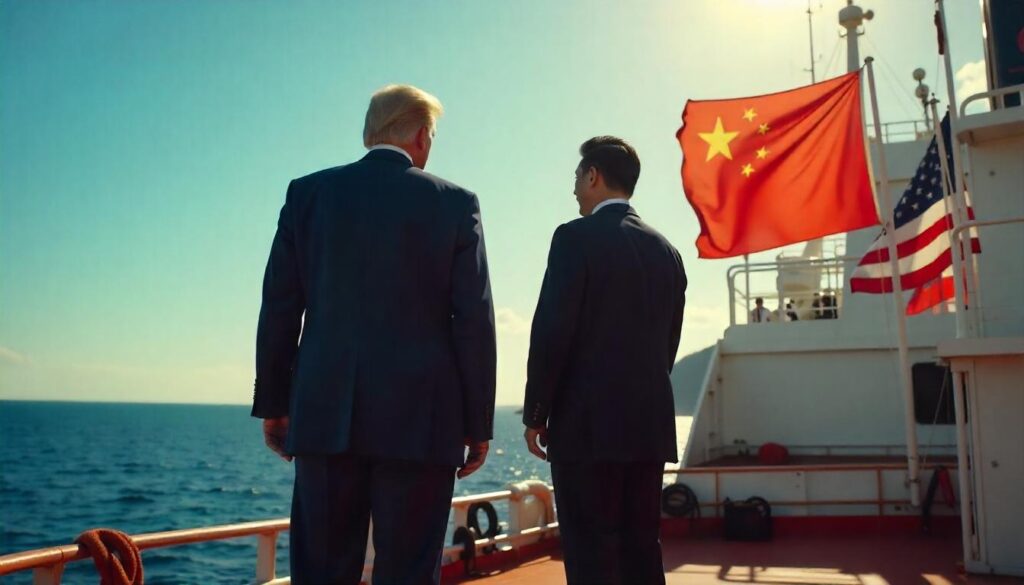
Obviously, public frustration is already boiling over. So, who could possibly be benefitting from this utter chaos? The short answer: almost no one, unless a fair agreement is reached soon.
A few may scrape by with modest gains, but for the big majority, it’s a slow-motion economic train wreck.
Sure, a handful of U.S. manufacturers—like steel plants in Ohio or Pennsylvania—might see a temporary boost. With tariffs hitting 10% across the board and 145% on Chinese imports, foreign competition is certainly throttled. Domestic factories might see a brief uptick in orders, and maybe even a few hundred new jobs. But don’t expect a manufacturing renaissance.
When Trump tried a similar move in 2018, steel prices spiked, but hiring barely moved. It’s a narrow win, lost in a sea of red ink.
Additionally, some foreign players might slip in and fill the gaps. Brazil could perhaps sell more soybeans to China now that U.S. farmers are sidelined by Canada’s 25% retaliatory tariffs. India might export more textiles and pharmaceuticals as Chinese goods get priced out. Singapore, shielded by an old trade agreement, could see a bump in port traffic.
But these are marginal wins—scavenged opportunities while the global economy is on the verge of breakdown.
And the losers? Well, they’re everywhere. Everyone is losing.
So, who’s really winning? A couple of domestic steel executives. A few countries grabbing at trade scraps.
Oh yeah, and of course, Trump family as they are certainly shorting or longing the market depending on what will be announced later that day. That’s it.
Everyone else—families, farmers, shop owners, even entire industries—is losing ground fast. This isn’t a strategy. It’s economic self-sabotage disguised as strength. Trump’s tariff gamble isn’t delivering prosperity.
It’s fueling inflation, breaking supply chains, and pushing small businesses to the brink. The chaos is real—and the cost is only rising.
Of course, unless a good trade agreement is reached with most countries, and quickly.
And in the end, we must ask ourselves, where is all this leading, is there an end at all, and what are some possible scenarios?
Tariffs– Scenarios for 2025 and Beyond
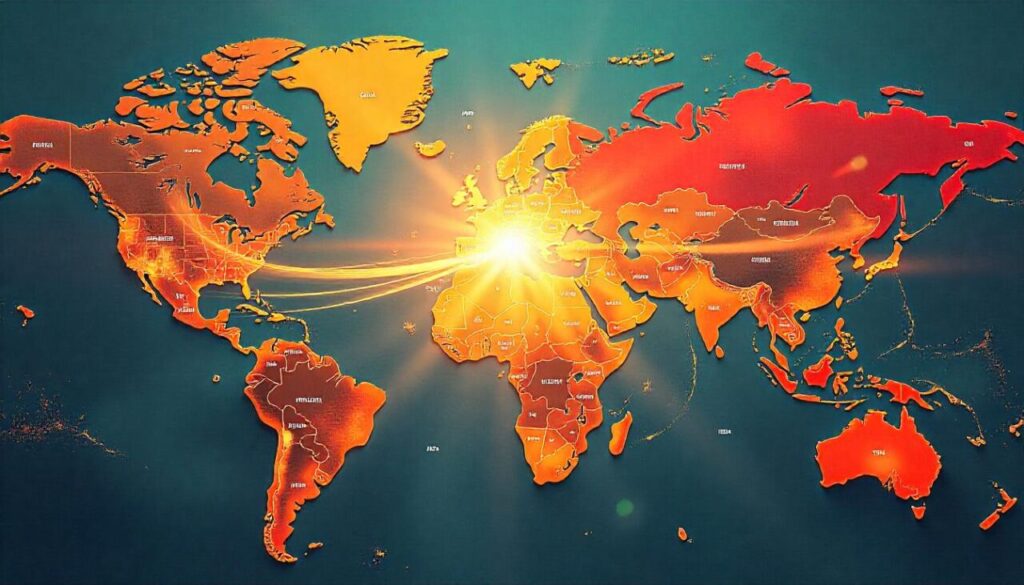
Damage has been done. And as the smoke rises, one question remains: Will we see a new world order or just a bigger mess?
Well, the future now really hangs by a thread, with several possible scenarios ahead. And of course, no one can predict the future, but let’s look at a couple of scenarios.
Scenario 1: All Countries Agree and We Get a Fair Trade System
This would be the best case for all of us. Imagine a rare moment when the world really comes together. It’s mid-2025, and Trump’s tariff storm generates a miracle—a “Global Fair Trade Pact” that stitches most of the pieces back into place.
Tariffs drop to a gentle 5%, trade begins to thrive again, and a wave of prosperity shines in everyone’s eyes. Well, this is certainly the scenario that most people hope for. So, let’s take a closer look at the details.
- How Could This Happen? The EU, facing billions in lost U.S. exports, might hold a big meeting in Brussels. China, hurt by 145% tariffs on its huge market, could send negotiators, though reluctantly. Canada and Mexico might use the USMCA to help push the deal through. By July 2025, most countries might sign leading to trade and market boom.
This is the best option and if it happens – the sooner the better. I’d give this option a 20% chance of happening.
Scenario 2: USA and China Trade War Continues, USA Agrees with India to Replace China, and China Finds New Partners
What if the U.S.-China trade war drags on, but the U.S. pivots to India as its new manufacturing hub while China scrambles for other allies? By late 2025, Trump’s tariffs could solidify a tectonic shift, with India stepping in to fill China’s shoes and China creating new trade blocs to survive.
Notably, Trump met with Indian Prime Minister Narendra Modi on February 13, 2025—over a month before the tariff escalations—hinting this might have been a calculated play all along.
- How Could This Happen? The U.S., with its 145% tariffs on China’s $438 billion in exports, could strike a deal with India, which already lowered tariffs on U.S. goods like bourbon and motorcycles in February 2025. Modi, eager to boost India’s $89 billion export to the U.S., might fast-track a pact to shift 60% of U.S. manufacturing from China to India’s factories in Tamil Nadu and Gujarat. China, facing a big export loss, could turn to Russia, Brazil, and Southeast Asia, building a rival trade network.
- Consequences: U.S. imports from China drop 50%—while India’s exports to the U.S. surge 40%. U.S. manufacturing jobs rise modestly—500,000 added—but costs climb as India’s infrastructure lags. China’s new bloc boosts its exports to Brazil by 20 and Russia by 15% softening the problems.
- Sub-Scenario A: U.S. firms like Apple and Nike double India’s output—iPhone production hits 30% of global supply—but bottlenecks in India’s ports and power grid delay deliveries, hiking costs 10%. U.S. rural factories lose 100,000 jobs as focus shifts overseas again.
- Sub-Scenario B: China floods Southeast Asia with cheap goods—Vietnam’s exports to the U.S. fall 15% initiating a regional price war.
This feels like a 25% chance. Trump’s Modi meeting suggests a strategic pivot, but China’s not out—it’s got the people and stubbornness to find new friends fast.
Scenario 3: Currency Wars Break Out
Or what if money becomes the big battleground? By mid-2025, Trump’s tariffs could start additional problems, with countries cutting their currencies to survive.
It would be a dark and deep dive into disaster.
- How Could This Happen? China might slice the yuan 25%, softening the blow of 145% tariffs. The EU could chop the euro 20% to dodge U.S. duties. Japan might trim the yen 15%, adopting to exports. The U.S. could counter, weakening the dollar 12%, a desperate swing in a spiraling fight. Bankers could lose sleep with currencies turning to ash.
- Consequences: U.S. inflation spikes to 9% by 2026 a $2,000 TV climbs to $2,600. Global trade falls 30. Small businesses collapse—25% shut down, 7 million jobs lost. Gold hits $4000 an ounce.
- Sub-Scenario A: Bitcoin spikes to $250,000. Average people lose 30% of their savings.
This is not a good scenario at all. But chances are there – let’s say around 15%.
Scenario 4: Partial Trade Deal
What if the world settles for half a deal? By 2026, Trump’s tariffs could force a shaky “Partial Trade Accord,” a patchwork fix that calms some waters but leaves plenty roiling. It’s not victory—just a limp through the wreckage.
- How Could This Happen? The EU might agree on a 10% tariff cap. China could agree to 50% duties. Canada and Mexico might hold at 15% retaliation, tweaking USMCA. Smaller players likely stay out.
- Global trade grows 5%, U.S. jobs rise modestly by 200,000. Prices drop slightly—a $100 blender now costs $80. The trade deficit shrinks by 10%. Stocks recover slightly. GDP grows 1.5%, offering a small relief.
Something like this could happen – let’s put a 30% probability label on that one.
Scenario 5: Transition to an AI and Robot Economy
This is an interesting scenario. By 2030, Trump’s tariffs (among other things) could push major powers like the U.S., China, and the EU into a world where AI and robots produce everything, from cars to cornflakes. Jobs disappear, wealth shifts and governments try to fix the problem with something radical: Universal Basic Income (UBI). It’s a new era, full of both excitement and problems.
- How Could This Happen? The U.S. might spend $700 billion on automation (2025-28 budgets), relying on robots to avoid tariffs and rebuild the economy. China, already using robots in 50% of its factories, could increase this to 90%, aiming for complete self-sufficiency. The EU might invest €400 billion, and Japan $300 billion, each trying to outpace the others in technology. By 2030, factories could be mostly automated, with fewer human workers. Tariffs may no longer matter as nations depend on machines. Politicians, seeing job losses, might introduce UBI—a monthly check for everyone—to maintain stability and avoid protests.
- Consequences: Global trade drops 60%. U.S. manufacturing jobs fall by 40%, as robots take over. Wages decrease by 15%, and the median income drops to $50,000. Prices stay stable, but wealth becomes even more concentrated. UBI might be $1,000 a month per adult, paid by taxing tech giants like Amazon, Apple, Google, etc..
- Sub-Scenario: AI leads to a tech war—U.S. and China hack each other’s power grids, causing $1 trillion in damage. Tech stocks like Tesla rise 50%, reaching a $2 trillion valuation, while debates over UBI continue. Congress could be split—half want $2,000 a month, while others call it socialism—delaying UBI.
Now while this might sound like something from science fiction it could become reality as early as 2030. And let’s put a probability of around 10% on that even though it might be much higher as AI, Quantum, and Robotics advance at unparalleled speed.
Final Thought

So where are we at? Honestly, I’m not really sure. No one can say with any certainty what will happen—because, truthfully, no one knows what Trump or Xi Jinping might decide tomorrow. Heck, even they probably don’t know their next move, despite all the talk about 3D, 4D, or even 8D chess.
Namely, trade works not because it’s efficient, but because it’s the least-broken thing we have in common. Break it completely, and we don’t go back to the past—we go sideways into something unrecognizable.
Let’s not do that.
Let’s just hope that all of this will lead to a better world—especially for the middle and lower classes. Yes, it sounds like a utopia, but perhaps humanity is finally ready for something better.
It’s a pity that 8.2 billion of us depend on the decisions of a few. Perhaps one day, AI will truly take over—and play a fairer game than all those politicians and leaders.
A game that is genuinely sustainable for the coming decades, centuries, and millennia.





